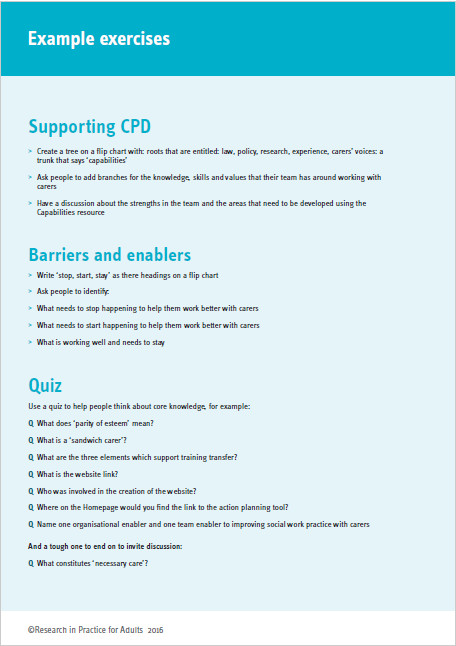
Download Example exercise (PDF file).
- Supporting CPD
- Barriers and Enablers
- Quiz
- Assessment
- Sculpting
Example exercises
Supporting CPD
- Create a tree on a flip chart with: roots that are entitled: law, policy, research, experience, carers’ voices: a
trunk that says ‘capabilities’ - Ask people to add branches for the knowledge, skills and values that their team has around working with
carers - Have a discussion about the strengths in the team and the areas that need to be developed using the
- Capabilities resource
Barriers and enablers
- Write ‘stop, start, stay’ as three headings on a flip chart
- Ask people to identify:
- What needs to stop happening to help them work better with carers
- What needs to start happening to help them work better with carers
- What is working well and needs to stay
Quiz
Use a quiz to help people think about core knowledge, for example:
Q What does ‘parity of esteem’ mean?
Q What is a ‘sandwich carer’?
Q What are the three elements which support training transfer?
Q What is the website link?
Q Who was involved in the creation of the website?
Q Where on the Homepage would you find the link to the action planning tool?
Q Name one organisational enabler and one team enabler to improving social work practice with carers
And a tough one to end on to invite discussion:
Q What constitutes ‘necessary care’?
Case study role play
The facilitator asks for volunteer(s) to be the carer(s) in one of the five case study situations, and someone to be the assessor. Practice tool: Vignette, ecogram and chronology
Role play: Assessment
- Participants then role play the first meeting of the assessor and the carer. Practice tools: One page Profile and Carer’s Assessment.
- The facilitator pauses the role play at different points asking what is and isn’t working at that point in time.
- The facilitator asks for suggestions from participants to improve the communication between the assessor, the carer and the cared for person.
- Observers of the role play can take the place of any of the players at any point by gently touching them on the shoulder and then taking their seat.
Role play: Sculpting
- The facilitator asks for volunteers to ‘stand in’ for all relevant figures in the case study. Practice tool: Ecogram.
- The facilitator then literally places the ‘stand-ins’ around the room, leading them by the shoulder to the most ‘right’ or ‘true’ spot.
- Important variables in the creation of a picture representing the case scenario include proximity/distance, inside/outside the group, and orientation with respect to others.
- Participants can be chosen to represent absent people (previous network, bereavement, former self), groups of people (departments, organisations), abstract concepts (the future, ambitions, hoped for connections). Practice tools: Vignette, Chronology.
- Once a 3D picture or ‘sculpt’ has been created the facilitator asks each stand-in to say how it feels to stand where they have been placed, to be in that position.
- The facilitator now invites the person who is the carer to change the sculpt, moving people (individuals, organisations, concepts) to where he or she would like them to be. Practice tools: One page Profile, Carers Assessment.
- Changes may be aimed at improvements or simply at ‘trying something out ’. The facilitator can sound out the stand-ins first to see to what extent they want to change position.
- Each player is then invited to explain how it feels to be in this new position.
- Finally the facilitator helps everyone to de-role (by inviting them to say who they were and who they really are) and for key people in the scenario, particularly the person playing the carer, to say what they have learned from the exercise.
Top tips for practice
- Watch the video of carers talking about what is important to them
- Ask people to identify how they would want to be treated as carers
- Share the Top tips for practice resource and ask people to identify how they can make this happen in their team
Critical reflection
- Use the Critical reflection tool to talk about a case.
- In a small group, one person volunteers to talk about a situation of social work with carers
- The others listen and ask questions for five minutes to gather information on the following areas:
- Think about a recent event or situation that involved a dilemma. Take each point of the reflective cycle in turn so that you can learn from what happened.
Experience – what happened: before; during; and after the event or situation?
Emotion – how did you feel and how did others feel at the time; how do you feel now?
Analysis – what did this event or situation mean to you and to others; what did it remind you of and what was unusual about it?
Action – what do you need to do in order to understand your role and others’ roles in the event or situation; how can you make progress; how can you use what you have learnt with others?
Action planning
- Use the Action planning tool to identify how you will move from reflection into action so that learning you have
gained from our experience can be transferred into your practice. - On your own or with a colleague, use the tool to think through what you have learned and what you will do.








